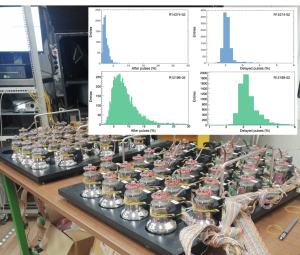Our tests of more than 200 new Hamamatsu R14374-02 photomultiplier tubes (PMTs) show better quantum efficiency and more uniform response across the photocathode surface compared to the previous model.
We also measured a significantly better time performance of the new photomultiplier with cleaner, more precise signals and fewer delayed pulses and afterpulses.
This means sharper detection of the faint Cherenkov light generated by relativistic charged particles induced by neutrino interactions. In particular it means a lower noise level and overall a better performance of the KM3NeT neutrino telescope.
The upgrade of the optical modules of our detectors with this new 3-inch PMT represents yet another step forward for deep-sea neutrino astronomy!
The paper has been submitted to the Journal of Instrumentation and is available as a preprint at arXiv 2504.02989.
In the picture the instrumental setup in the CAPACITY lab with PMTs for two optical modules ready for tests in a dark box. In the inlay the distributions of the percentage of measured afterpulses and delayed pulses for the new R14374-2 PMTs (blue) and the old R12199-2 PMTs (green). The distributions of the new PMTs peak at lower values and are significantly narrower.


